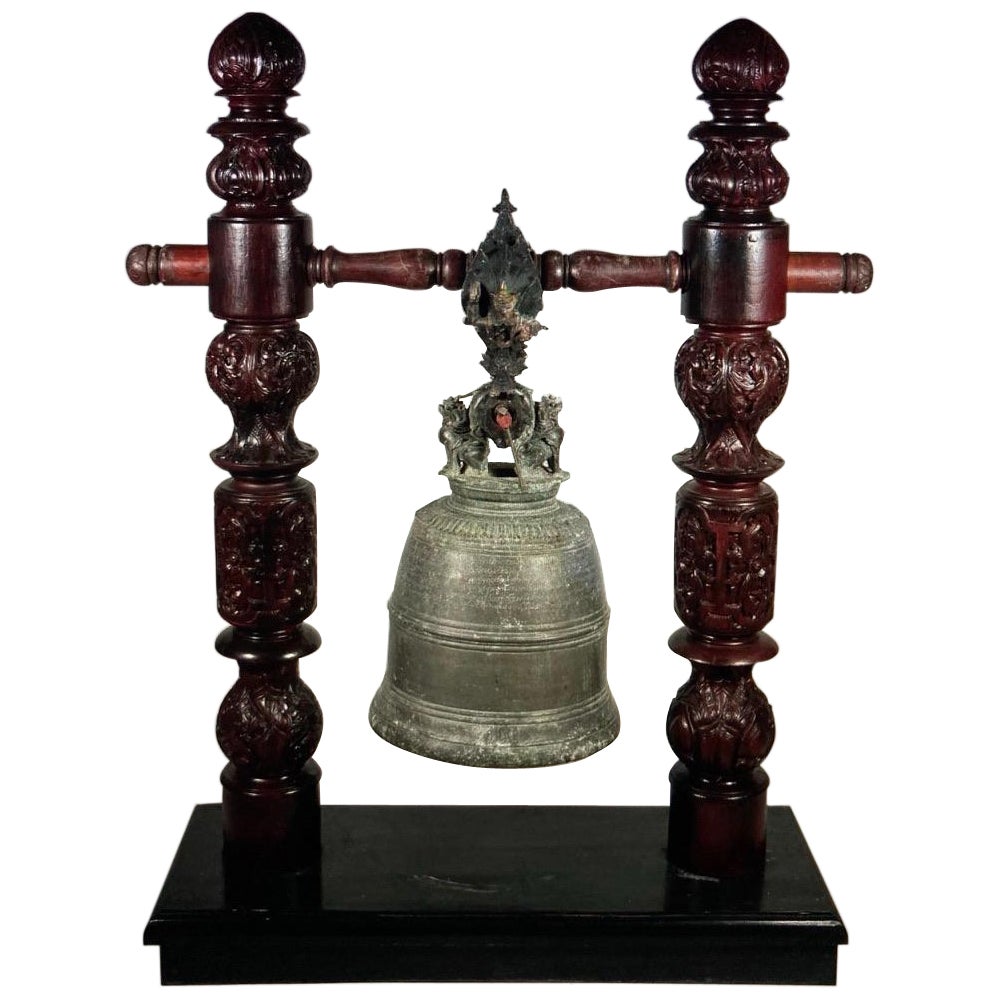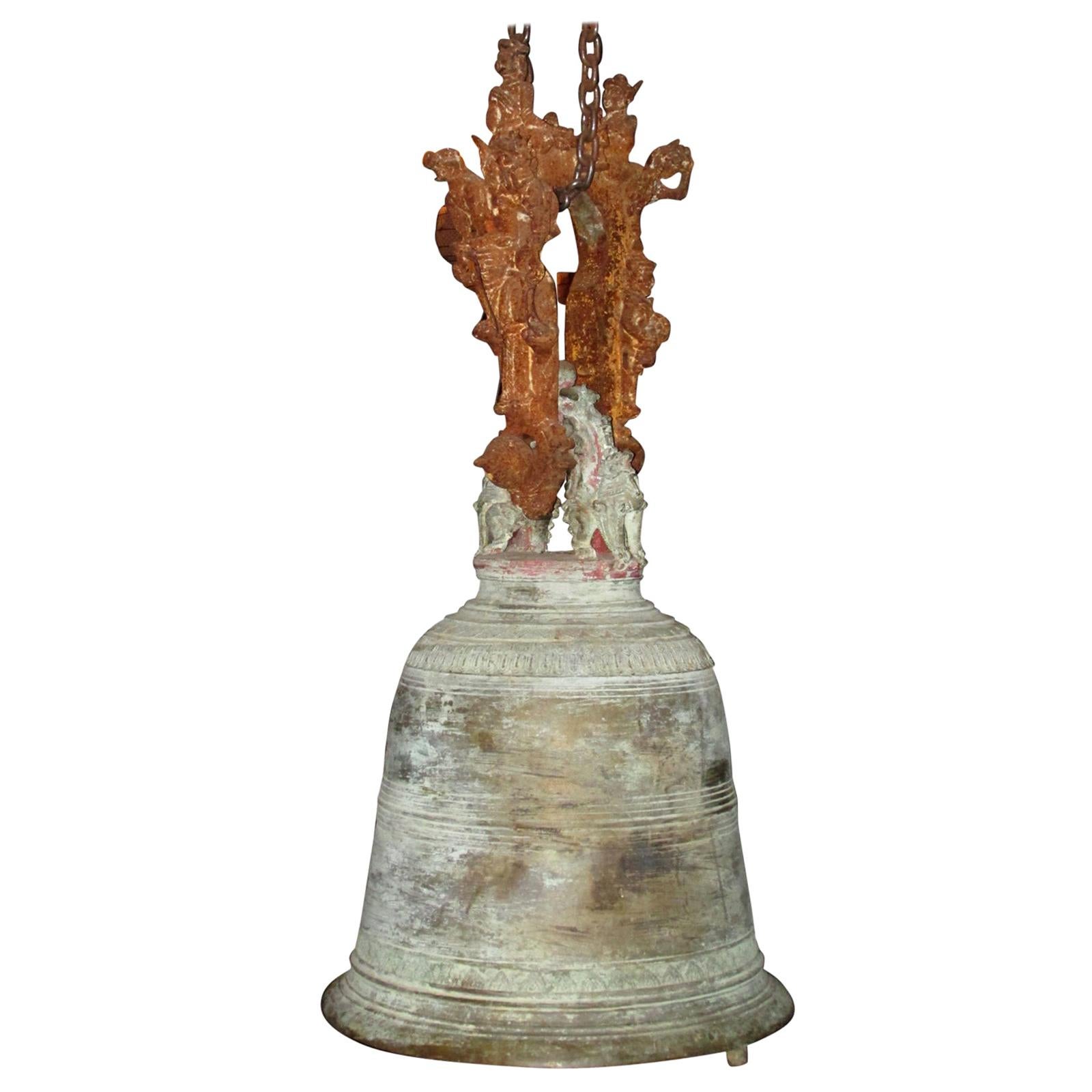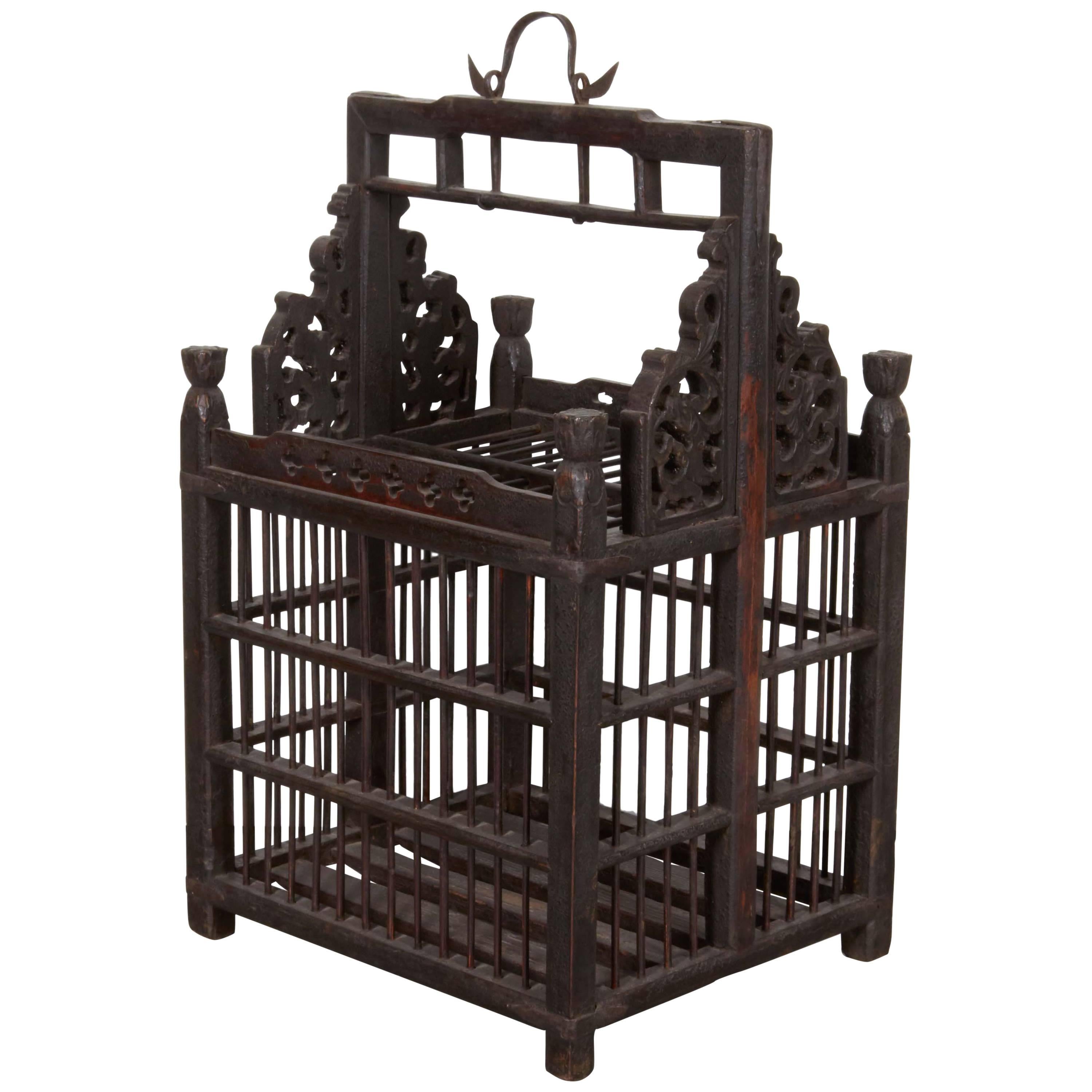Items Similar to Massive 19th Century Cast Iron Temple Bell From China
Want more images or videos?
Request additional images or videos from the seller
1 of 9
Massive 19th Century Cast Iron Temple Bell From China
About the Item
An unusually large and striking cast iron temple bell with custom iron stand. Beautifully patinated from years of use, this piece virtually emanates age and spirituality. The rough casting markings add visual interest and authenticity to this object.
One look and you can imagine the Buddhist monks gathering at the sound of this bell.
And this bell is not only beautiful, it has a very pleasing sound. China, Shanxi Province, c. 1850.
Dimensions : L: 24 DL18 H:29
M59
- Dimensions:Height: 29 in (73.66 cm)Width: 24 in (60.96 cm)Depth: 18 in (45.72 cm)
- Materials and Techniques:
- Place of Origin:
- Period:
- Date of Manufacture:1850
- Condition:Wear consistent with age and use. Minor losses. Minor fading.
- Seller Location:New York, NY
- Reference Number:
About the Seller
5.0
Vetted Seller
These experienced sellers undergo a comprehensive evaluation by our team of in-house experts.
Established in 2003
1stDibs seller since 2013
278 sales on 1stDibs
Typical response time: 5 hours
- ShippingRetrieving quote...Ships From: New York, NY
- Return PolicyA return for this item may be initiated within 3 days of delivery.
More From This SellerView All
- 19th Century Cast Iron Temple BellLocated in New York, NYAn early 19th Century cast iron temple bell with two distinct horizontal bands. Custom iron stand included. From China, Shanxi Province, circa 1820.
...CategoryAntique 19th Century Chinese More Asian Art, Objects and Furniture
MaterialsIron
- 19th Century Chinese BirdcageLocated in New York, NYA carefully constructed 19th century Chinese birdcage with original hand-forged iron hanger. From Shanxi Province, circa 1880. M739.Category
Antique 1890s Chinese Bird Cages
MaterialsWood
- Antique Chinese Cast Iron WeightLocated in New York, NYA tall, solid cast iron 19th century Chinese weight. Beautifully worn, with original hand forged hanger. A heavy piece with presence and history. Meas...Category
Antique Mid-19th Century Chinese More Asian Art, Objects and Furniture
MaterialsIron
- 19th Century Embossed Cast Iron BellLocated in New York, NYA beautifully embossed early 19th Century Chinese cast iron bell suspended from original chain and mounted on custom iron stand. China, Shanxi Province,...Category
Antique 19th Century Chinese More Furniture and Collectibles
MaterialsIron
- 18th Century Chinese Cast Iron BellLocated in New York, NYA decorated 18th Century cast iron bell from Shanxi Province with beautiful patina throughout and a lovely tone. Includes custom-made contemporary iron ...Category
Antique 18th Century and Earlier Chinese Decorative Objects
MaterialsIron
- 19th Century Pendant with Great PatinaLocated in New York, NYA stunning and rare 19th century amulet with detailed central imagery of a man astride a horse. This piece, from India, conveys it's age and history through the gorgeous patina created over several generations. Worn with a simple leather cord or silver chain, this antique amulet...Category
Antique Late 19th Century Indian Collectible Jewelry
MaterialsSilver
You May Also Like
- 19th Century Burmese Bronze Temple Bell with StandLocated in Stamford, CT19th century Burmese bronze temple bell with original carved hard wood stand, painted iron hanging bracket, and striker. This rare cast bronze bell has a splendid sculptural and spiritual presence. The bell has a long inscription on the upper part. The offering of a bronze bell to a monastery or temple was considered second only to the offering of a Buddha image as an act of merit (kutho). Such bells were cast using the lost wax (cire perdue) method. Casting of such bells was auspicious with specific rituals being performed by the caster and sponsors to ensure the appropriate blessings. The bell here, as with all such Burmese bells...Category
Antique Mid-19th Century Burmese Tibetan Metalwork
MaterialsBronze, Iron
- Late 19th Century Canopy Bed from Shanxi, ChinaLocated in Singapore, SGAn antique canopy bed from Shanxi province made of Elm wood. This bed has all the attention focused on the front carvings while keeping a very simpl...Category
Antique Late 19th Century Chinese Qing Furniture
MaterialsRattan, Elm
- Monumental Burmese Bronze and Iron Temple BellLocated in Lambertville, NJA huge antique bronze bell with iron top. This large bell has all the original patination from many years of use and exposure. The iron also has all its original oxidation. This bell used...Category
Antique 19th Century Asian More Asian Art, Objects and Furniture
MaterialsBronze, Iron
- 19th Century Chinese ScreenLocated in New York, NYThis Chinese standing screen has a main panel, and a lower panel flanked by two smaller ones, which were made in the 19th century as fretwork window panels for a house. In the 20th century they were salvaged, assembled, and mounted in a matching hardwood stand as a freestanding screen...Category
Antique Late 19th Century Chinese Qing Furniture
MaterialsHardwood
- 19th Century Chinese RugLocated in New York, NY19th century Chinese rug in shades of creamy white and blue irregular thin striped motif throughout with 4 symbolic Chinese figures signaturi...Category
Antique 19th Century Chinese Mid-Century Modern Chinese and East Asian Rugs
MaterialsWool
- A pair of 19th Century carved Foo temple dogs or Chinese guardian LionsLocated in London, GBChinese guardian lions, or imperial guardian lions, are a traditional Chinese architectural ornament. Typically made of stone, they are also known as stone lions or shishi (石獅; shíshī). They are known in colloquial English as lion dogs or foo dogs / fu dogs. The concept, which originated and became popular in Chinese Buddhism, features a pair of highly stylized lions—often one male with a ball and one female with a cub—which were thought to protect the building from harmful spiritual influences and harmful people that might be a threat. Used in imperial Chinese palaces and tombs, the lions subsequently spread to other parts of Asia including Japan (see komainu), Korea, Philippines, Tibet, Thailand, Myanmar, Vietnam, Sri Lanka, Nepal, Cambodia, Laos, and Malaysia. There has been extensive interaction between Chinese mythology and Confucianism, Taoism, and Buddhism. Elements of pre-Han dynasty mythology such as those in Classic of Mountains and Seas were adapted into these belief systems as they developed (in the case of Taoism), or were assimilated into Chinese culture (in the case of Buddhism). Elements from the teachings and beliefs of these systems became incorporated into Chinese mythology. For example, the Taoist belief of a spiritual Paradise became incorporated into mythology as the place where immortals and deities used to dwell. Sometimes mythological and religious ideas have become widespread across China's many regions and diverse ethnic societies. In other cases, beliefs are more limited to certain social groups, for example, the veneration of white stones by the Qiang. One mythological theme that has a long history and many variations involves a shamanic world view, for example in the cases of Mongolian shamanism among the Mongols, Hmong shamanism among the Miao people, and the shamanic beliefs of the Qing dynasty from 1643 to 1912, derived from the Manchus. Politically, mythology was often used to legitimize the dynasties of China, with the founding house of a dynasty claiming a divine descent. Mythology and philosophy. Further information: Chinese philosophy True mythology is distinguished from philosophical treatises and theories. Elaborations on the Wu Xing are not really part of mythology, although belief in five elements could appear. The Hundred Schools of Thought is a phrase suggesting the diversity of philosophical thought that developed during the Warring States of China. Then, and subsequently, philosophical movements had a complicated relationship with mythology. However, as far as they influence or are influenced by mythology, divides the philosophical camps into two rough halves, a Liberal group and a Conservative group. The liberal group being associated with the idea of individuality and change, for example as seen in the mythology of divination in China, such as the mythology of the dragon horse that delivered the eight bagua diagrams to Fu Xi, and methods of individual empowerment as seen in the Yi Jing (Book of Changes). The Liberal tendency is towards individual freedom, Daoism, and Nature. The relationship of the Conservative philosophies to mythology is seen in the legendary Nine Tripod Cauldrons, mythology about the emperors and central bureaucratic governance, Confucianism, written histories, ceremonial observances, subordination of the individual to the social groups of family and state, and a fixation on stability and enduring institutions. The distinction between the Liberal and Conservative is very general, but important in Chinese thought. Contradictions can be found in the details, however these are often traditional, such as the embrace by Confucius of the philosophical aspects of the Yi Jing, and the back-and-forth about the Mandate of Heaven wherein one dynasty ends and another begins based according to accounts (some of heavily mythological) where the Way of Heaven results in change, but then a new ethical stable dynasty becomes established. Examples of this include the stories of Yi Yin, Tang of Shang and Jie of Xia or the similar fantastic stories around Duke of Zhou and King Zhou of Shang. Mythology exists in relationship with other aspects of society and culture, such as ritual. Various rituals are explained by mythology. For example, the ritual burning of mortuary banknotes (Hell Money), lighting fireworks, and so on. A good example of the relationship of Chinese mythology and ritual is the Yubu, also known as the Steps or Paces of Yu. During the course of his activities in controlling the Great Flood, Yu was supposed to have so fatigued himself that he lost all the hair from his legs and developed a serious limp. Daoist practitioners sometimes incorporate a curiously choreographed pedal locomotion into various rituals. Mythology and practice, one explains the other: in these rituals, the sacred time of Yu merges with the sacral practice of the present. Various ideas about the nature of the earth, the universe, and their relationship to each other have historically existed as either a background or a focus of mythologies. One typical view is of a square earth separated from a round sky by sky pillars (mountains, trees, or undefined). Above the sky is the realm of Heaven, often viewed of as a vast area, with many inhabitants. Often the heavenly inhabitants are thought to be of an "as above so below" nature, their lives and social arrangements being parallel to those on earth, with a hierarchical government run by a supreme emperor, many palaces and lesser dwellings, a vast bureaucracy of many functions, clerks, guards, and servants. Below was a vast under ground land, also known as Diyu, Yellow Springs, Hell, and other terms. As time progressed, the idea of an underground land in which the souls of the departed were punished for their misdeeds during life became explicit, related to developments in Daoism and Buddhism. The underground world also came to be conceived of as inhabited by a vast bureaucracy, with kings, judges, torturers, conductors of souls, minor bureaucrats, recording secretaries, similar to the structure of society in the Middle Kingdom (earthly China). Chinese temple Dogs...Category
Antique 1860s Chinese Chinese Export Sculptures and Carvings
MaterialsHardwood





